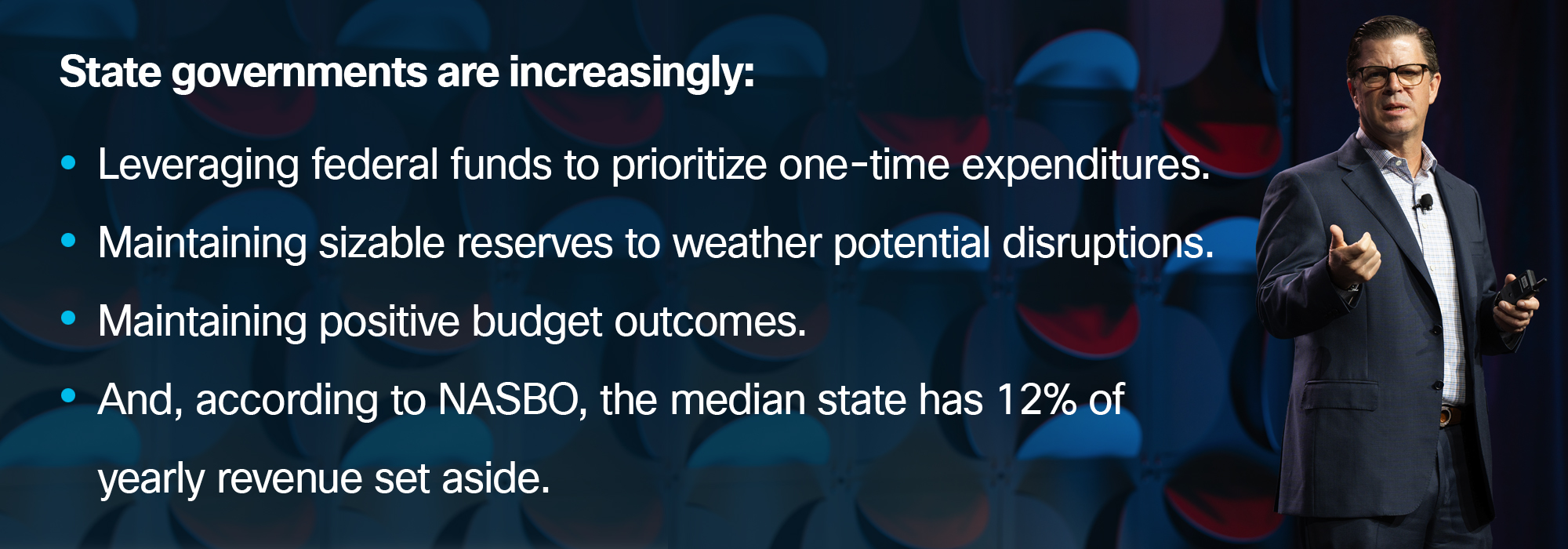Despite ongoing challenges facing the public sector, including cyber threats, workforce shortages, and the overwhelming need to transform government services, there is good news for those tasked with leading IT modernization efforts in state and local government: the government technology market is stable, resilient, and continuing to grow.
This news bodes well for ongoing efforts to redefine the workforce, foster cyber resilience, expand digital equity, reimagine government services delivery, and modernize critical infrastructure. Furthermore, IT is now viewed as an enabler of productivity and a means to improve how government services are delivered in our communities.
Technology trends in state and local governments
According to recent research from the Center for Digital Government, state, local government, and education (SLED) IT spending is expected to grow between three to five percent from 2023 to 2028. In fact, IT-related spending is outpacing U.S. GDP. While not as explosive as the levels seen during the pandemic, IT market growth remains resilient. While state and local governments are returning to “normal” in terms of budgeting and procurement, significant federal stimulus funding is still available for state use in IT modernization, including enhancing cybersecurity and expanding broadband. Regardless of any short-term economic turbulence, the 5-year outlook for SLED is positive.
This market outlook unlocks opportunities for state and local governments to increasingly deliver on priority areas such as workforce development, cybersecurity, digital equity, citizen experience, and critical infrastructure modernization.
State governments are increasingly:
- Leveraging federal funds to prioritize one-time expenditures.
- Maintaining sizable reserves to weather potential disruptions.
- Maintaining positive budget outcomes.
- And, according to NASBO, the median state has 12% of yearly revenue set aside.
Like their colleagues at the state level, local leaders have significant unused federal funding they can access to modernize IT. The Coronavirus State and Local Fiscal Recovery Funds (SLFRF) program is providing up to $350 billion to state, territorial, local, and Tribal governments across the country to support their response to and recovery from the COVID-19 public health emergency. Both state and local governments have until the end of 2024 to budget and obligate their SLFRF allocations, which can be used for a variety of IT modernization efforts including network upgrades, mobile technologies, and cybersecurity.

The bottom line
The government technology market is resilient and, in times of economic or communal distress, will adapt to strengthen mission-critical technologies and services. This has been shown time and again, especially during the Great Recession and the COVID-19 pandemic.
At Cisco, we’re seeing the desire among state governments to reshape how their workforce collaborates by providing innovative tools, like Webex for Government, that speed and simplify communications. We’re also seeing a desire to reimagine government workspaces and real estate to better support hybrid work (more here). Governments are also modernizing their contact centers to improve the quality and availability of government services. Cisco Webex Contact Center is being leveraged by many governments for more rapid, efficient delivery of citizen services, increasing government responsiveness, and gaining constituent trust.
There is also a strong push by state and local governments towards automation and augmentation to better protect their networks and data. States are wisely ramping up their cyber defenses and adopting solutions that proactively detect emerging threats, automate actions, and streamline security analysts’ responses to threats and incidents.
As the security perimeter expands to include increasingly mobile workers, MFA solutions including Cisco Duo are being widely adopted to effectively control access to and from government-managed and non-government devices and connections. Additionally, governments are starting to adopt cloud-based content filtering technologies such as Cisco Umbrella to meet compliance with state mandates and executive orders banning high-risk social media applications. States are also in various stages of planning for a comprehensive, coordinated statewide security strategy following CISA guidance and initial funding provided within IIJA.
Additional Resources
- IIJA grant eligible solutions for US infrastructure
- Leveraging IIJA for Cybersecurity: How to align the new federal funding to your needs
- State and local government funding opportunities


Great perspective, Gary! Thanks for sharing and being a strong champion and advocate for our SLED customers.
Interesting insight. Will be watching to see how it plays out over the next year.
Our biggest issue is growth. We are getting so many new residents that we just can’t keep up with demand. Any technology that we can deploy quick and easy, and at or below budget will be a win for us. So we’re definitely looking at SaaS, subscriptions as long term solutions first.